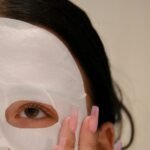Proper makeup removal is a crucial aspect of skincare that is often overlooked. Many individuals may think that simply washing their face at the end of the day is sufficient, but this is a misconception that can lead to various skin issues. The skin is exposed to environmental pollutants, dirt, and makeup throughout the day, and failing to remove these impurities can result in clogged pores, breakouts, and dullness.
Moreover, makeup can contain ingredients that, if left on the skin overnight, may lead to irritation or allergic reactions. Therefore, understanding the importance of thorough makeup removal is essential for maintaining healthy skin. In addition to preventing breakouts and irritation, proper makeup removal plays a significant role in the overall effectiveness of a skincare routine.
When makeup is not adequately removed, it can hinder the absorption of serums, moisturizers, and other beneficial products applied afterward. This means that even the most expensive and high-quality skincare products may not deliver their intended results if the skin is not properly cleansed first. Thus, establishing a consistent and effective makeup removal routine is vital for anyone who wears makeup regularly.
Choosing the Right Makeup Remover for Your Skin Type
Selecting the appropriate makeup remover tailored to your skin type is essential for achieving optimal results without causing irritation. For individuals with oily or acne-prone skin, oil-based removers may seem counterintuitive; however, they can effectively dissolve heavy makeup and excess sebum without stripping the skin of its natural oils. Gel-based or foaming cleansers are also excellent options for this skin type, as they provide a deep clean while helping to control oil production.
Conversely, those with dry or sensitive skin should opt for gentler formulations. Creamy or lotion-based removers are ideal for these skin types, as they hydrate while effectively breaking down makeup. Micellar water has gained popularity in recent years due to its versatility and gentle nature; it can be used on all skin types and requires no rinsing, making it a convenient option for those with sensitive skin.
Understanding your skin’s unique needs will help you choose a makeup remover that not only cleanses effectively but also maintains your skin’s health.
Step-by-Step Guide to Removing Makeup
The process of removing makeup should be methodical to ensure that every trace of product is eliminated. Begin by gathering your supplies: a suitable makeup remover, cotton pads or reusable cloths, and a gentle cleanser. Start by applying the makeup remover to a cotton pad and gently pressing it against your eyelids for a few seconds to allow the product to break down eye makeup.
This step is crucial, especially for waterproof formulas that can be stubborn to remove. Once the eye makeup has been dissolved, use a fresh cotton pad to remove foundation, blush, and other face products. It’s important to work in sections, starting from the center of the face and moving outward.
This technique ensures that all areas are thoroughly cleansed without spreading makeup around. After removing all visible makeup, follow up with a gentle cleanser to wash away any remaining residue and impurities. This two-step process not only ensures complete removal but also prepares your skin for subsequent skincare treatments.
Special Considerations for Eye Makeup Removal
Eye makeup removal requires special attention due to the delicate nature of the skin around the eyes. The area is thinner and more sensitive than other parts of the face, making it susceptible to irritation if not treated with care. When removing eye makeup, it’s advisable to use products specifically formulated for this purpose.
Look for eye makeup removers that are labeled as hypoallergenic or ophthalmologist-tested to minimize the risk of irritation. When using an eye makeup remover, apply it gently with a cotton pad without rubbing or pulling at the skin. Instead of scrubbing, allow the remover to sit on the lashes and eyelids for a few moments to dissolve the product effectively.
For those who wear waterproof mascara or eyeliner, consider using an oil-based remover, as it can break down these stubborn formulas more efficiently than water-based options. After removing eye makeup, it’s essential to rinse the area with water or follow up with a gentle cleanser to ensure no residue remains.
The Dangers of Improper Makeup Removal
Neglecting proper makeup removal can lead to several adverse effects on the skin. One of the most immediate consequences is clogged pores, which can result in blackheads and acne breakouts. When makeup mixes with dirt and oil on the skin’s surface, it creates an environment conducive to bacterial growth, leading to inflammation and blemishes.
Over time, this neglect can also contribute to premature aging signs such as fine lines and wrinkles due to a lack of proper cleansing. Moreover, improper removal can exacerbate existing skin conditions such as eczema or rosacea. The buildup of products can irritate sensitive skin and trigger flare-ups.
Additionally, leaving makeup on overnight can disrupt the skin’s natural barrier function, leading to dehydration and increased sensitivity. Therefore, understanding these dangers underscores the necessity of establishing a diligent makeup removal routine as part of daily skincare practices.
Tips for Removing Long-Wear and Waterproof Makeup
Choosing the Right Products
Long-wear and waterproof makeup products are designed for durability, but they can be challenging to remove. To effectively tackle these stubborn formulations, it’s essential to use the right techniques and products. Start by using an oil-based makeup remover or micellar water specifically designed for waterproof makeup. These products contain ingredients that can break down long-lasting formulas without excessive scrubbing.
Removing Waterproof Eye Makeup
When dealing with waterproof mascara or eyeliner, consider using a two-step approach: first, apply an oil-based remover directly onto the lashes and let it sit for a few moments before gently wiping away with a cotton pad. This method allows the product to penetrate and dissolve stubborn makeup without damaging delicate lashes or skin around the eyes.
Removing Foundation and Face Products
For foundation and other face products, layering an oil-based remover followed by a gentle cleanser will ensure complete removal while maintaining skin integrity.
Using Gentle and Effective Techniques for Makeup Removal
Employing gentle techniques during makeup removal is crucial for preserving skin health. Rubbing or scrubbing too vigorously can lead to irritation and damage the skin barrier. Instead, use soft motions when applying your chosen remover; this minimizes friction while effectively breaking down makeup.
For instance, when using cotton pads or cloths, press gently against the skin rather than dragging them across. Incorporating tools such as silicone cleansing brushes can enhance your makeup removal routine without being harsh on the skin. These brushes provide a gentle exfoliation while helping to lift away residual makeup and impurities.
Additionally, consider using lukewarm water instead of hot water when rinsing your face; hot water can strip natural oils from the skin and lead to dryness or irritation.
Incorporating Makeup Removal into Your Skincare Routine
Integrating makeup removal into your overall skincare routine is essential for achieving healthy skin. It should be viewed as a foundational step rather than an afterthought. Ideally, makeup removal should occur as part of a two-step cleansing process: first with a dedicated remover followed by a gentle cleanser suited to your skin type.
This approach ensures that all traces of makeup are eliminated while preparing your skin for subsequent treatments. After removing your makeup and cleansing your face, consider following up with additional skincare steps such as toning or applying serums and moisturizers. These products work best on clean skin, allowing them to penetrate more effectively and deliver their benefits without interference from leftover makeup residue.
Establishing this routine not only enhances your skincare regimen but also promotes overall skin health.
The Role of Cleansing and Toning after Makeup Removal
Cleansing after makeup removal serves as an essential step in ensuring that all impurities are thoroughly eliminated from the skin’s surface. While a dedicated makeup remover may dissolve most products, residual traces can still linger if not followed by a proper cleansing routine. A gentle cleanser tailored to your specific skin type will help remove any remaining debris while maintaining hydration levels.
Toning is another critical component that should not be overlooked after cleansing. Toners help restore pH balance to the skin while providing additional hydration and preparing it for subsequent skincare products. They can also help tighten pores and remove any last traces of impurities left behind after cleansing.
Incorporating both cleansing and toning into your post-makeup removal routine will enhance overall skin clarity and health.
Avoiding Common Mistakes in Makeup Removal
Several common mistakes can undermine even the best intentions when it comes to makeup removal. One prevalent error is using harsh scrubs or exfoliants during this process; while exfoliation is beneficial in moderation, it should not be part of daily makeup removal routines as it can lead to irritation and compromised skin barriers. Instead, focus on gentle techniques that prioritize thoroughness without causing damage.
Another mistake is neglecting specific areas such as behind the ears or along the hairline where makeup often accumulates unnoticed. Failing to address these areas can lead to breakouts or irritation over time. Additionally, many individuals may skip eye makeup removal altogether or use inappropriate products that can cause discomfort or damage delicate lashes.
Being mindful of these common pitfalls will help ensure an effective and safe makeup removal process.
Seeking Professional Advice for Makeup Removal Issues
For individuals experiencing persistent issues related to makeup removal—such as breakouts, irritation, or allergic reactions—seeking professional advice from a dermatologist or skincare specialist is advisable. These professionals can provide personalized recommendations based on individual skin types and concerns while addressing any underlying issues that may be contributing to problems. In some cases, they may suggest specific products or techniques tailored to your unique needs or recommend treatments that can help restore balance to your skin after prolonged exposure to heavy makeup use.
Consulting with professionals ensures that you receive expert guidance tailored specifically to your situation, ultimately leading to healthier skin and improved confidence in your skincare routine.
FAQs
What are the potential risks of not removing makeup properly?
Not removing makeup properly can lead to clogged pores, breakouts, and skin irritation. It can also contribute to premature aging and damage to the skin’s natural barrier.
What is the best way to remove makeup without damaging the skin?
The best way to remove makeup without damaging the skin is to use a gentle, oil-based cleanser or micellar water to dissolve and lift the makeup from the skin. Follow up with a gentle cleanser to remove any remaining residue.
How often should makeup be removed?
Makeup should be removed every night before bed to prevent buildup and potential skin issues. Even if you don’t wear makeup, it’s important to cleanse your skin to remove dirt, oil, and environmental pollutants.
Can improper makeup removal cause long-term damage to the skin?
Yes, improper makeup removal can lead to long-term damage to the skin, including accelerated aging, increased sensitivity, and a compromised skin barrier. It can also contribute to the development of acne and other skin conditions.
Are there any specific techniques or products that should be used for removing eye makeup?
When removing eye makeup, it’s important to use a gentle, oil-based makeup remover specifically formulated for the eyes. Avoid rubbing or tugging at the delicate skin around the eyes, and use a soft cotton pad or cloth to gently wipe away the makeup.









